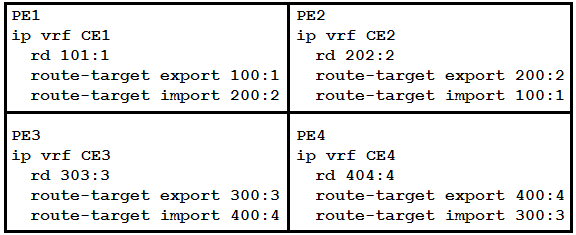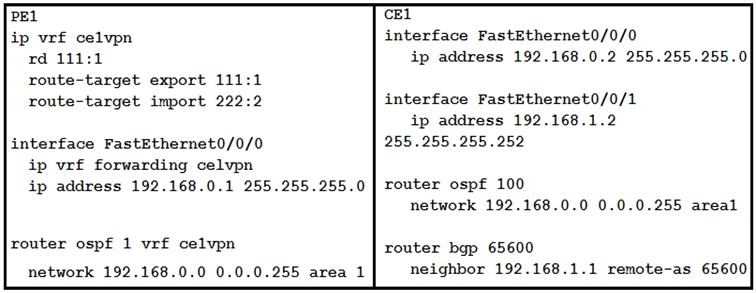Cisco® 300-515 Exam Practice Questions (P. 1)
- Full Access (107 questions)
- Six months of Premium Access
- Access to one million comments
- Seamless ChatGPT Integration
- Ability to download PDF files
- Anki Flashcard files for revision
- No Captcha & No AdSense
- Advanced Exam Configuration
Question #1

Hi! Do you need help with this question ?
- Why isn't the A the right answer?
- Traducir la pregunta al español
Contributor get free access to an augmented ChatGPT 4 trained with the latest IT Questions.
Question #2
- AIt enables the router to support multiple separate routing tables, which allows the device to handle overlapping IP addresses.
- BIt enables a router to run BGP and a distance vector routing protocol at the same time, which allows it to serve as a VPN endpoint between remote sites.
- CIt enables a router to configure VLANs locally, which provides segregation between networks.
- DIt enables the router to provide faster switching through the network by using labels to identify the input and output interfaces for neighbor routers.
A

Hi! Do you need help with this question ?
- Why isn't the A the right answer?
- Traducir la pregunta al español
Contributor get free access to an augmented ChatGPT 4 trained with the latest IT Questions.
Question #3
- ALayer 2 VPNs use IPsec tunneling, but Layer 3 VPNs use L2TPv3 tunneling.
- BLayer 2 VPNs use AToM, but Layer 3 VPNs use MPLS/BGP.
- CLayer 2 VPNs use BGP, but Layer 3 VPNs use VPLS.
- DLayer 2 VPNs use L2TPv3 tunneling, but Layer 3 VPNs use GRE tunneling.
- ELayer 2 VPNs use IPsec tunneling, but Layer 3 VPNs use pseudowires to provide tunneling.
BD

Hi! Do you need help with this question ?
- Why isn't the A the right answer?
- Traducir la pregunta al español
Contributor get free access to an augmented ChatGPT 4 trained with the latest IT Questions.
Question #4

Refer to the exhibit. A network engineer has been called to configure the four PE devices in order to enable full communication among the four CE devices connected to them. While starting to configure, he experienced a connectivity issue. Which two tasks should the engineer perform in order to begin the process correctly? (Choose two.)
- AConfigure PE3 to export route-targets 100:1 and 200:2.Most Voted
- BConfigure PE3 to import route-targets 100:1 and 200:2.
- CConfigure PE4 to import route-targets 101:1 and 202:2.Most Voted
- DConfigure PE2 to export route-targets 300:3 and 400:4.
- EConfigure PE1 to import route-targets 300:3 and 400:4.
AB

Hi! Do you need help with this question ?
- Why isn't the A the right answer?
- Traducir la pregunta al español
Contributor get free access to an augmented ChatGPT 4 trained with the latest IT Questions.
Question #5

Refer to the exhibit. If the two devices are operating normally, which two conclusions can you draw from this configuration? (Choose two.)
- ACE1 must use OSPF to establish a neighbor relationship with PE1.Most Voted
- BPE1 labels the routes it learns from CE1 with the route-target 222:2 and shares them with its VPNv4 peers.
- CPE1 labels the routes it learns from CE1 with the route-target 111:1 and shares them with its VPNv4 peers.Most Voted
- DThe PE-CE routes between the devices are being exchanged by OSPF
- ECE1 is supporting CSC.
AD

Hi! Do you need help with this question ?
- Why isn't the A the right answer?
- Traducir la pregunta al español
Contributor get free access to an augmented ChatGPT 4 trained with the latest IT Questions.
All Pages
